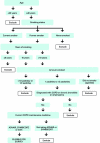Evaluation of patient preference and willingness to pay for attributes of maintenance medication for chronic obstructive pulmonary disease (COPD)
- PMID: 24890711
- PMCID: PMC4240911
- DOI: 10.1007/s40271-014-0064-1
Evaluation of patient preference and willingness to pay for attributes of maintenance medication for chronic obstructive pulmonary disease (COPD)
Abstract
Background: Chronic obstructive pulmonary disease (COPD) is a leading cause of morbidity and mortality worldwide. COPD is characterized by poor treatment adherence, and patient medication preferences may contribute to adherence.
Methods: A discrete choice experiment with an internet panel drawn from the USA was used to evaluate preference and willingness to pay (WTP) of COPD patients for long-acting maintenance medications. Key attributes derived from earlier qualitative research (brief literature review and focus groups) with COPD patients on maintenance therapy included symptom relief, speed of feeling medication start to work, inhaler ease of use, rescue medication use, side effects, and monthly out-of-pocket co-pay. Patients were presented with hypothetical medications with different profiles and asked which they preferred. Utilities and marginal WTP in monthly co-pay dollars were estimated for all patients and by severity.
Results: Utilities for 515 participants were in the expected direction and highest for the most favorable attribute levels. Each attribute evaluated was important, and participants were willing to pay a premium to obtain each benefit. On average, WTP was as high as $US64 for complete symptom relief, $US59 for no side effects, $US32 to rarely use rescue medication, $US16 for a quick and easy to use inhaler, and $US13 for feeling medication work quickly (within 5 min; average WTP $US18/month for patients with severe/very severe COPD).
Conclusion: As expected, efficacy and safety were most valued by patients; however, this study showed that other COPD medication attributes, such as rescue medication, ease of use, and feeling medication work quickly, are also important in patient preferences.
Figures
Similar articles
-
Patient preferences for dry powder inhaler attributes in asthma and chronic obstructive pulmonary disease in France: a discrete choice experiment.BMC Pulm Med. 2017 Jul 6;17(1):99. doi: 10.1186/s12890-017-0439-x. BMC Pulm Med. 2017. PMID: 28683805 Free PMC article.
-
Maintenance inhaler preference, attribute importance, and satisfaction in prescribing physicians and patients with asthma, COPD, or asthma-COPD overlap syndrome consulting for routine care.Int J Chron Obstruct Pulmon Dis. 2018 Mar 16;13:927-936. doi: 10.2147/COPD.S154525. eCollection 2018. Int J Chron Obstruct Pulmon Dis. 2018. PMID: 29588581 Free PMC article.
-
Qualitative assessment of attributes and ease of use of the ELLIPTA™ dry powder inhaler for delivery of maintenance therapy for asthma and COPD.BMC Pulm Med. 2013 Dec 7;13:72. doi: 10.1186/1471-2466-13-72. BMC Pulm Med. 2013. PMID: 24314123 Free PMC article. Clinical Trial.
-
Patient preferences in severe COPD and asthma: a comprehensive literature review.Int J Chron Obstruct Pulmon Dis. 2015 Apr 8;10:739-44. doi: 10.2147/COPD.S82179. eCollection 2015. Int J Chron Obstruct Pulmon Dis. 2015. PMID: 25914530 Free PMC article. Review.
-
Long-acting bronchodilator therapy for the treatment of chronic obstructive pulmonary disease.Ann Pharmacother. 2008 Dec;42(12):1832-42. doi: 10.1345/aph.1L250. Epub 2008 Oct 28. Ann Pharmacother. 2008. PMID: 18957624 Review.
Cited by
-
Intravenous versus Subcutaneous Drug Administration. Which Do Patients Prefer? A Systematic Review.Patient. 2014 Jul 12. doi: 10.1007/s40271-014-0075-y. Online ahead of print. Patient. 2014. PMID: 25015302
-
A Systematic and Critical Review of Discrete Choice Experiments in Asthma and Chronic Obstructive Pulmonary Disease.Patient. 2022 Jan;15(1):55-68. doi: 10.1007/s40271-021-00536-w. Epub 2021 Jul 12. Patient. 2022. PMID: 34250574 Free PMC article.
-
Does co-payment for inhaler devices affect therapy adherence and disease outcomes? A historical, matched cohort study.Pragmat Obs Res. 2017 Apr 18;8:31-41. doi: 10.2147/POR.S132658. eCollection 2017. Pragmat Obs Res. 2017. PMID: 28458590 Free PMC article.
-
Process value of care safety: women's willingness to pay for perinatal services.Int J Qual Health Care. 2017 Aug 1;29(4):484-489. doi: 10.1093/intqhc/mzx049. Int J Qual Health Care. 2017. PMID: 28486625 Free PMC article.
-
Patient preferences for dry powder inhaler attributes in asthma and chronic obstructive pulmonary disease in France: a discrete choice experiment.BMC Pulm Med. 2017 Jul 6;17(1):99. doi: 10.1186/s12890-017-0439-x. BMC Pulm Med. 2017. PMID: 28683805 Free PMC article.
References
-
- World Health Organization. Chronic obstructive pulmonary disease (COPD) burden; 2011. http://www.who.int/respiratory/copd/burden/en/index.html. Accessed March 2011.
-
- Mannino DM, Homa DM, Akinbami LJ, et al. Chronic obstructive pulmonary disease surveillance—United States, 1971–2000. MMWR Surveill Summ. 2002;51:1–16. - PubMed
-
- Global Initiative for Chronic Obstructive Lung Disease (GOLD). Global strategy for diagnosis, management, and prevention of COPD. Revised 2011. http://www.goldcopd.org/guidelines-global-strategy-for-diagnosis-managem.... Accessed 1 June 2012.
-
- National Institute for Health and Clinical Excellence (NICE). Chronic obstructive pulmonary disease: management of chronic obstructive pulmonary disease in adults in primary and secondary care (update); 2010. http://guidance.nice.org.uk/CG101. Accessed 1 June 2012.
MeSH terms
Substances
LinkOut - more resources
Full Text Sources
Other Literature Sources
Medical
Research Materials




